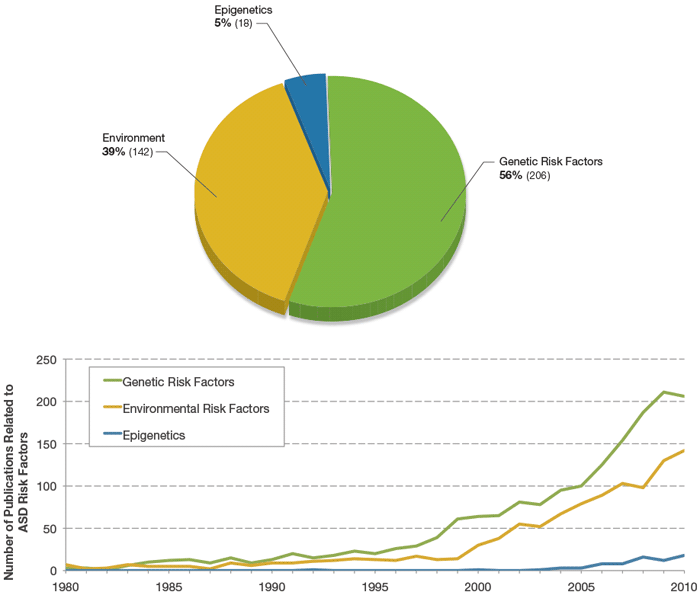Publications Analysis
Autism Spectrum Disorder Research
The Global Landscape of Autism Research
2012
Publication Output and Trends in Subcategories of Autism Risk Factor Research

Figure 10. Publication Output and Trends in Subcategories of Autism Risk Factor Research. The pie graph (top) illustrates relative proportions of research articles published in 2010 in three subcategories of ASD risk factor research and the line graph (bottom) shows the increase in number of publications in each subcategory over time from 1980 to 2010. Genetic Risk Factors research had the greatest number and proportion of publications, while the emerging field of Epigenetics had the smallest number and proportion of publications. The number of publications in each subcategory has been increasing over time, especially since 1999 for Genetic Risk Factors and Environmental Risk Factors and since 2006 for Epigenetics. Publications in this figure include both primary and secondary research. See Figure A-29 in Appendix I for publication output by primary research only.
With 1 in 88 children affected by autism, the patient and research communities feel a sense of urgency to identify risk factors that may be contributing to the rise in autism prevalence. Autism risk factor research has yielded some strong leads, but much work remains to identify a more complete picture of the risk factors that play the most significant role in the development of autism. Scientific evidence suggests that genetic and environmental risk factors form a complex web of interactions that determine whether a person develops an autism spectrum disorder.
To provide a clearer picture of research on autism risk factors, risk factor research publications were further classified into three subcategories:
- Genetic Risk Factors: This research includes efforts to identify new genes that are implicated in increased risk for ASD or to better understand previously identified genetic risk factors. Since the completion of the human genome map in 2003, scientists have identified a flood of genetic mutations that contribute to a variety of human diseases and disorders, and a few hundred genes have been implicated in autism.9,10,11 Some individuals on the autism spectrum have syndromes that result from single gene mutations, such as fragile X, tuberous sclerosis, and Rett syndrome; however, it is estimated that single gene disorders may only account for ~10-20% of all autism cases.12 The majority of the genetic mutations and alterations identified to date have much more subtle effects, individually accounting for only a small increase in risk.
- Environmental Risk Factors, including studies on the interaction of genes with the environment:iv Researchers are actively searching for pre- and postnatal environmental risk factors, either alone or in combination with genetic susceptibility (gene-environment).13 Some examples of environmental factors currently being explored in autism risk factor research include maternal dietary factors, maternal medications taken during pregnancy, child and maternal response to immune challenges and infection, environmental contaminants and toxins, as well as social changes in reproductive patterns and parental age. Environmental factors can interact with genetic factors in numerous ways. For example, they can cause novel mutations called de novo mutations in parents' germ line DNA. These molecular events can significantly affect development at various points throughout the lifespan.
- Epigenetic Processes: Epigenetics, an emerging area of research, is the study of heritable changes in gene function (such as methylation of DNA) that occur without changes to the DNA sequence. Environmental factors can alter epigenetic processes by affecting the molecules that bind DNA and control gene function. These epigenetic changes can be passed along from one generation to the next and have far-ranging biological consequences, potentially contributing to autism risk.14,15
In this analysis, which includes both primary and secondary research publications, Genetic Risk Factor publications comprised the largest share of 2010 publications (56%), followed by Environment (39%) and Epigenetics (5%). Major upturns in both Genetic and Environmental research have occurred in the last decade. An appreciable increase in genetics publications can be seen around 1998, and the field has matured since 2000, with large-scale genetics research now commonplace in the autism field. Environmental Risk Factor research is somewhat less established, but it has acquired substantial momentum over the last decade. Due to the relative youth of the Epigenetics research field in general, research on the role of epigenetics in autism has only emerged in the last few years, and represents a growing area of autism science. Very similar trends were observed when publication output analysis was restricted to primary research publications only. See Figure A-29 in Appendix I for more details. It will be important to continue to track developments in risk factors research to see if current trends continue or new research areas emerge.




